#mounted chasseurs
Text

Charge of the Mamelukes at the Battle of Austerlitz by Felician Myrbach
#battle of austerlitz#mamluks#mamelukes#cavalry charge#art#cavalry#france#egypt#europe#history#felician myrbach#napoleonic#napoleonic wars#mamluk#imperial guard#mounted chasseurs#chasseurs
82 notes
·
View notes
Text
6 July 1814
Just some random mentions I found in a German newspaper:
The Duc de Berry was at St.-Cloud on 6 July, then had his regiment of mounted chasseurs manoeuvre in the so-called Trou d'Enfer, and finally held a deer hunt with the Prince of Wagram (Berthier) in the forest of Saint-Germain. [...] Marshal Soult, Duke of Dalmatia, left Paris on 6 July to go to his governorate in Brittany. Marshal Mortier, Duke of Treviso, was also about to leave for his governorate, which included Flanders and Artois.
Nice to see they’re all well.
21 notes
·
View notes
Text

🇫🇷 The Dragons Portés were French motorized infantry during the interwar and early WWII, so-called because of their cavalry affiliation. They were the contemporaries of the Panzergrenadiers, although not as well resourced. The infantry branch's motorized infantry were called things like Chasseurs Portés or simply Infanterie motorisé. The Division Cuirassée (Armored Division that was subordinate to the infantry branch rather than the cavalry was meant to have a battalion of Chasseurs Portés or mounted chasseurs for example).
⚔ The Dragoons were part of the Light Mechanized Divisions (DLM) and Light Cavalry Divisions (DLC), the former of which was an entirely mechanized/motorized exploitation force. The organization shown is the DLM variant, which were mounted mainly on 6x6 off-road trucks. The smaller DLC variant was mounted on Citroen P19 Kegresse Half-Tracks. Each DLM division had one Dragoon regiment as infantry support.
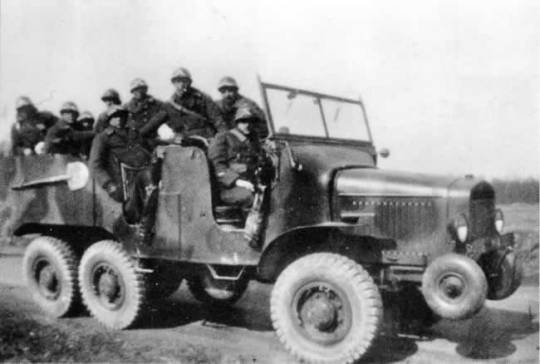
⚔ One or two Dragoon battalions were typically meant to reinforce a brigade-sized tactical group (Groupement tactique) under the division that consisted of a tank regiment (2 battalions), 1-2 Dragoon battalions and a squadron-sized Discovery Detachment (a mix of armored cars and motorcyclists for recon from the division's Discovery Regiment).
⚔ The Dragoon battalion itself had a reconnaissance squadron with AMR 35 light tanks, or H39 as a substitute. These tanks likely worked closely with the motorcyclists, as other units had mixed light tank-motorcycle squadrons in lieu. So it was a combined arms battalion in its own way. The battalion's MG and Support Vehicle Squadron had 8x 8mm MGs, 4x 81mm mortars and 4x 25mm AT cannons.
#armée de terre#french army#infantry#armor#infanterie#dragoons#ww2#wwii#military#military history#world war ii#infographic#orbat#battleorder
6 notes
·
View notes
Photo
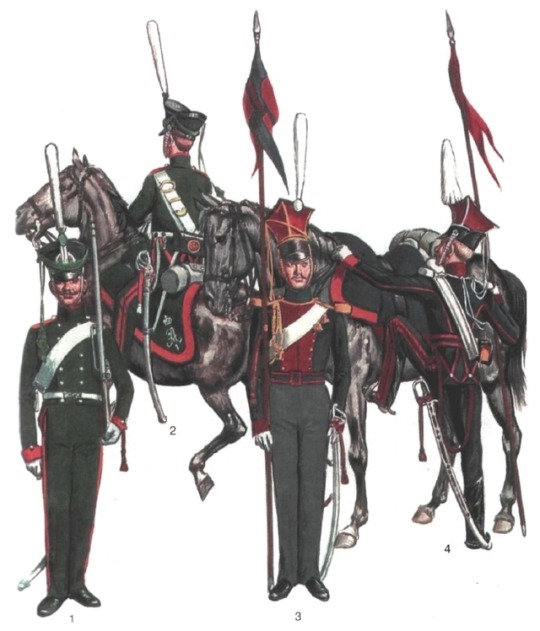
Russian Napoleonic cavalry, plates and text by Fred and Liliane Funken
1 & 2 - Mounted riflemen, 1813-14
3 & 4 - Lancers, 1809-15
47 notes
·
View notes
Photo

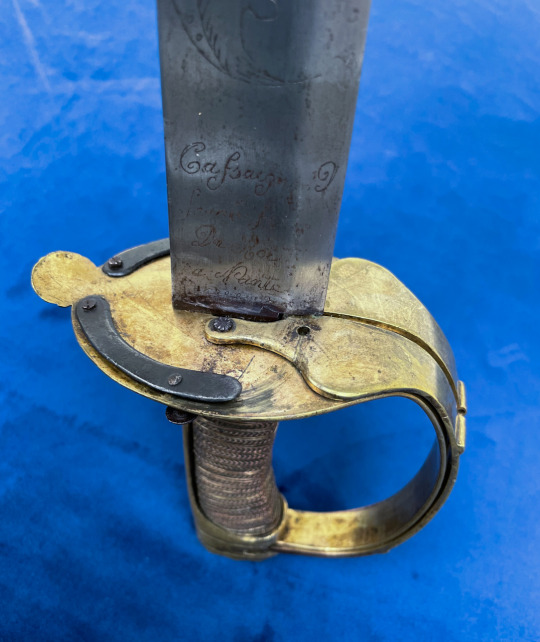

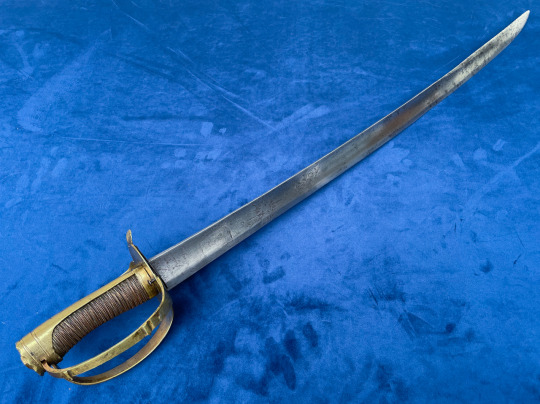


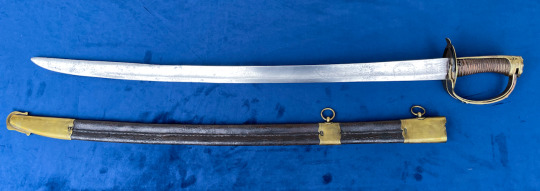
Mounted Infantry Officers Sabre with ‘Branches Tournantes’ - Rotating branches.
It is generally believed that this non-regulation style of sabre, with the rotating guard appeared around 1784, possibly corresponding to the Chasseur a Pied or Hunters on Foot, a Light Company style infantry unit that engaged in scouting and skirmishing actions.
To distinguish themselves from the regular line infantry, many officers adopted this model with an iron guard to match the silver on their uniforms.
Swords with brass guards followed around 1786 as officers of the line began to adopt the sabre for themselves as well. And on 14th May 1788 a Royal decision was announced, authorizing them to carry a sabre rather than a sword.
While predominantly taken up by infantry or naval officers, some were carried by mounted officers as well, and can be identified by their length and having three instead of two scabbard fittings so that it could be suspended from the officers’ belt.
Their use continued through the revolution, and they remained in service until around 1798 when they fell out of fashion.
This type of sword is a unique attempt to solve the issue of providing maximum hand protection when in use while being less of an encumbrance when worn at the side. They came with varying degrees of decoration from plain oval guards with one or two folding branches to pierced guards or even a full collapsing basket.
The mechanism is simple with the branches pivoting on their anchor points on the guard plate and a pin where they join the pommel. A piece of spring steel with a pin, holds the branch in place when extended and there is a button attached to the end to release it to fold back for when not in use.
On this sword, the two side branches fold out to offer plenty of space for the hand, but because of where the branches meet with the pommel, the sword is not suited to point work (like many basket hilts).
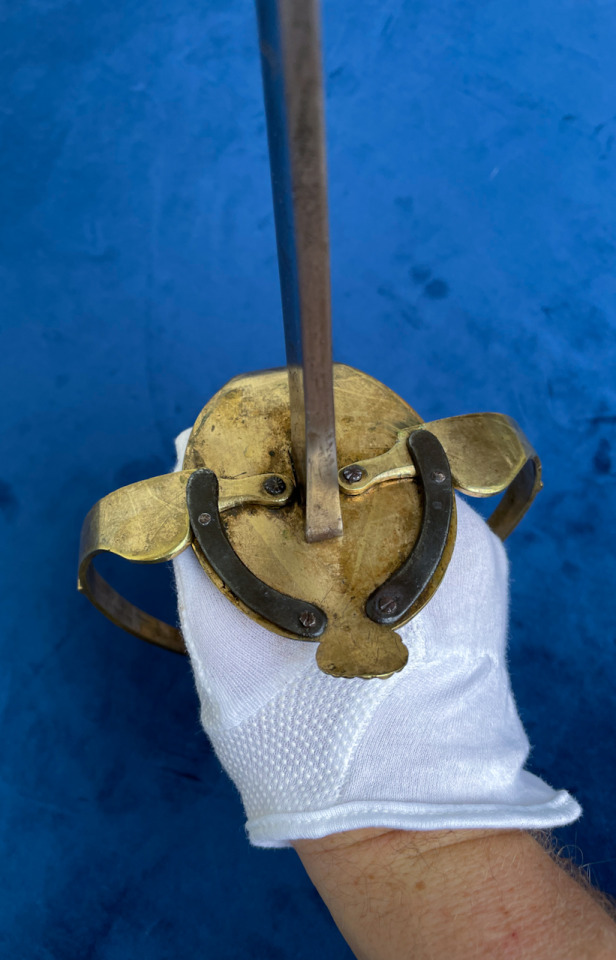
The ricasso is engraved with the makers name which reads:
Cassaignard Fourbisseur Du Roi à Nantes
Or translated:
Cassaignard, Cutler of the King in Nantes.
Cassaignard operated out of Nante from 1774 to 1812 as a Fourbisseur, an old French term for someone that finishes edged weapons, i.e. mounting hilts, decorating and polishing the blades. Being a port city, his mark in various forms appears on a lot of swords associated with Naval officers or Privateers. Due to the use of ‘Du Roi’ in the makers mark, we can be reasonably confident that this blade pre-dates the denouncement of King Louis XIV in 1792 when it became common practice to remove or deface the symbols of his reign.
The other decorations include the talismanic man in the moon, face in the sun and sword arm protruding from a cloud. These are typical of Solingen made blades, where Cassaignard likely purchased his stock from, and this combination of three items feature often on blades with his mark.
Overall Length: 920 mm
Blade Length: 788 mm
Grip Length: 130 mm
Inside Grip Length: 108 mm
Sword Weight: 810 grams
Total Weight: 1,180 grams
Point of Balance: 135 mm
Curve: 16 mm

#Sabre#Swords#French Revolution#18th Century#Infantry#Mounted officers#French Army#Antiques#Georgian Era#Revolutionary Wars
70 notes
·
View notes
Photo


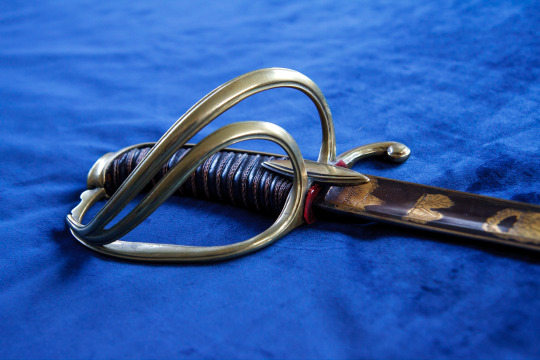
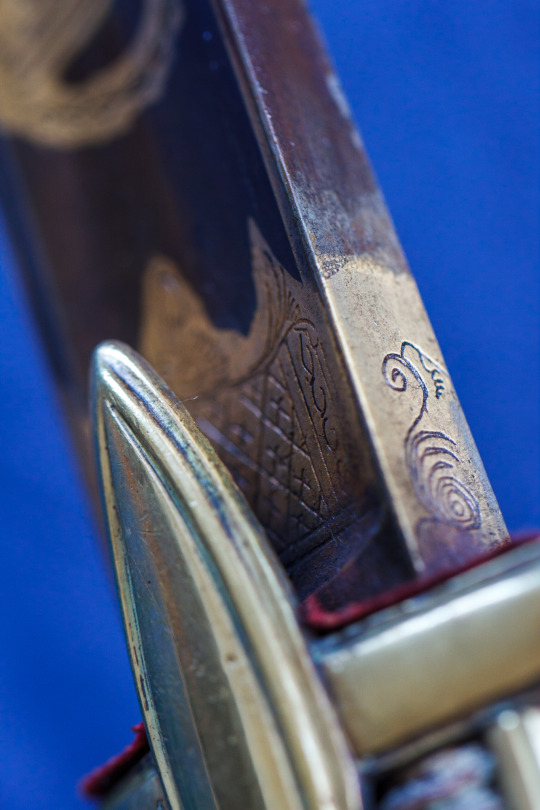

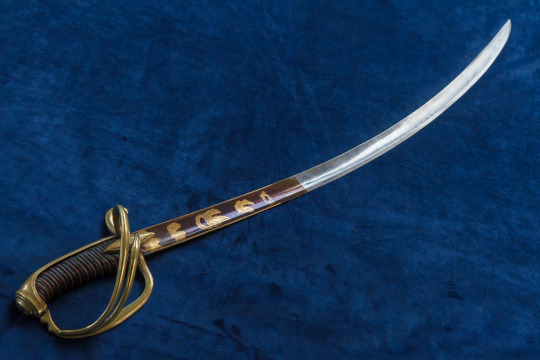


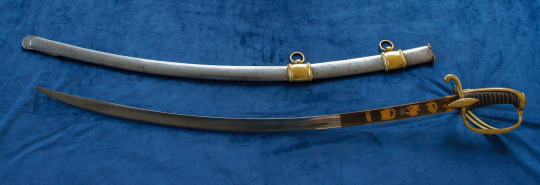
Sabre d’officer de Cavalerie legere - Modele de l’an XI
French swords of the 18th and early 19th century are commonly grouped by the political era that formed them. The Royal era ended in 1789 with the brutal French Revolution giving rise to the First Republic in 1792.
Split into the Directory and Consulate periods, the First Republic lasted until 18 May 1804 with the crowning of Napoleon as Emperor giving birth to the First Empire which lasted to 11 April 1814 and again with Napoleon’s return from exile March 1815 till his final defeat at Waterloo in 1815.
With Napoleon back in exile, the victorious allied nations restored the French monarchy, a period referred to as the Restoration Period which lasted until 1852.
To complicate things further, in 1792, full of revolutionary fervour the French Government decided to do away with the past and start afresh. This included the calendar. It was decided that they would go back to year one on 22 September 1792. So, the model year 11 is the same as the m.1802
As the name suggests, the An XI was introduced as a replacement sabre for the Light Cavalry in 1802, although an earlier model the An IX did see limited production before the design was finalised. Called the Chasseurs a cheval or hunters on horse, this hilt style is often referred to as the ‘hunter guard’ although the design saw service with all multiple mounted branches, including the mounted artillery.
The An XI, like many swords of the First Empire era continued to be used into the Restoration period. Because the trooper swords went through the government ordnance channels, they are marked with inspectors’ stamps and often the date of manufacture, making it relatively straightforward to date them.
Officer swords, however, are more difficult to date. Being private purchase lot of choice was available to the buyer in the specific features of the sword he wanted. Some were more focused on its’ suitability for combat, while others focused on the fashion aspect.
During the First Empire period, the German sword manufacturing centre of Solingen was under French control. Because of this, a lot of the An XI officer’s sword (and others) can from that region. This sword is one such example, produced in Solingen and retailed by the Schnitzler & Kirschbaum company, as seen by the S & K mark on the ricasso. S&K were operating from 1792 - 1864 and this sword probably dates from 1805 to 1810 based on the shape of the guard and pommel.
Overall Length - 985 mm
Blade Length - 850 mm
Grip Length - 130 mm
Inside Grip Length - 105 mm
Weight - 830 grams
Total Weigth - 1480 grams
Point of Balance - 130 mm
#French#First Empire#Light Cavalry#AN XI#cavalry#Napoleonic#Georgian#swords#sword#sabre#antique#antiques
247 notes
·
View notes
Text
The Light Cavalry in the Napoleonic Era
This is the rest of what David G. Chandler has to say about Napoleon’s cavalry in his The illustrated Napoleon:
Third, there was the light cavalry. These adventurous troopers wore the most extravagant uniforms, regarded themselves as “the darlings of the ladies”, and developed their own mystique. There were several types. By 1811 there were thirty-one regiments of chasseurs a cheval, between ten and fifteen regiments of hussars (the most sumptuously dressed of all) and eventually nine regiments of lancers (or chevau-legers lanciers), which were raised from a number of sources, including transferred squadrons (and some whole regiments) of chasseurs and dragoons. The light cavalry expanded when the French were called upon to fight Russian armies, which were strong in light horses and Cossacks. Hussars and chasseurs carried similar weaponry - sabers, carbines and pistols - and were often brigaded together to form regiments of between twelve hundred and eighteen hundred men serving in between four and eight squadrons. Light horsemen also (from 1809) carried the eight-foot lance. As might be expected, the light horsemen were strongly represented in the cavalry of the Imperial Guard. There was an Old Guard Regiment de Chasseurs a Cheval from 1804, the Company (later Squadron) of Mamelukes first raised in Egypt in 1799, also attached to the Old Guard, like the First (1807) and the Second (1810) Regiments de Chevaux-lanciers, known respectively as the Polish Blue and the Dutch Red Lancers of the Guard, and three regiments of Eclaireurs raised in 1814, four more of Gardes d’Honneur (from 1813), and the Legion de Gendarmerie d’Elite, going back to 1804.
Light cavalry duties were particularly arduous and included playing many roles in reconnaissance and pursuit. The Imperial Guard imperial cavalry usually provided the emperor’s personal escort on campaign; Napoleon’s favourite garb was the green undress uniform of a colonel of chasseurs a cheval. The most celebrated commanders of light cavalry included Colbert, Lasalle, and Lefebvre-Desnouettes.
Such, in barest outline, was l’arme blanche of la Grande Armee. There were also numerous provisional and allied regiments of all types raised for short periods of time. The mounted arm was transformed from a near-laughingstock in the Armies of the Revolution into a most formidable weapon, which perhaps saw its greatest days from late 1806 to 1812, when the horse studs from Prussia were available to supply the deficiencies in French horseflesh (1).The pursuit after Jena-Auerstadt was a masterpiece of light cavalry operation, and the heavy cavalry arguably saw its finest day at the battle of Eylau in 1807.
(1) I swear to the gods that I initially read “horseflesh” as “horseradish”. I can imagine Daru rushing into Napoleon’s cabinet in complete panic: “Sire, the troops are about to run out of horseradish!” Napoleon, choking on his Chicken Marengo: “Running out of horseradish?!? We must invade Prussia most urgently! It has abundant supplies of horseradish!”
On another topic, I wonder if names such as Eclaireurs, Gardes d’Honneur, and Gendarmerie d’Elite, were created to make its members feel distinctive and increase cohesion among them, or if these units actually had particular functions. And isn’t the Gendarmerie associated with maintaining civil order more than with combat roles?
David G. Chandler, The Illustrated Napoleon. New York: Henry Holt and Company, 1973, 1990. Pp. 95-97
27 notes
·
View notes
Text
While Mount Blanc, The White Mountain, retains its name in the horror AU, saying it brings to mind the home of fae. Urban legend has it that a soldier in the first world war stumbled across the mother of all fae in his den, and that they fell in love. The soldier's death caused the mother so much grief that it affects the whole mountain and the forests below them.
All sorts of magical creatures, from the straight up tiny winged creatures to the grotesque and beautiful fair folk to such things as loups-garous and feu follet have, supposedly, been seen across the barrier of the man-made fence or slipping out from behind the fence.
But there are some creatures born straight from the mountain, and not born of other myths.
After the expansion, the soldiers who guard the mountain are called Chasseurs de la Forêt(hunters of the forest), or Les Chasseurs de Maman(mother's hunters), and while they do communicate with other military branches and cooperate, they do not defer to them nor the French government. They do as they please and after the expansion, both the French and Swiss governments leave well the fuck enough alone. If you go and visit the outpost, offerings aren't required... but gifts of alcohol, meats, and ammunition tend to bring you better luck during your stay there. It's highly discouraged to try and take home a souvenir, though. Everything from bad luck to your death by the very object you stole can be expected to happen. Media, recording devices, and other forms of information gathering are banned vehemently and even joking about taking pictures will get you thrown out of the outpost.
The masked people sometimes seen flitting in between the trees are called Les Honteux(the ashamed), and are said to be the souls of those who trespassed on Mother's land without permission nor respect. Their bodies are said to be twisted like gnarled limbs and their faces covered with bark and ivy. They're often used in local children's tales to keep kids from trespassing and to teach them to respect what belongs to someone else. To drive one away, it's said you must threaten to call Mother on them--in the same childish way one sibling would threaten to call Mom on another.
The third most well known sighting is the Fleurs Mortes(flowering dead) or Amants de la Mère(mother's lovers). These are people that Mère des Pins has called over personally, and the most famous of these is L'oeil(the eye), for whom Mère called for so passionately that he expanded his forest for her in a raging tantrum until she returned to his side. The flowering dead have many different forms, but are always cadavers brought alive by vines. That occasionally leave the perimeter set by the fence to peek on the living. They're said to be violent in the winter, but playful and even joyful and helpful in the summer. If you want to seek out one's help in the warm months or keep your family safe in the winter, offerings of honey, meat, and wine are gleefully taken.
L'oeil herself is said to be the smartest and most dangerous of the flowering dead, and is known for the bright blue blossom in her right eye. She can still talk fluently and her debates can drive any sane man backwards in their own skull. She is said to be lulled by gifts of bones, black silk, and sugary treats, and you must refer to her as Lieutenant if you ever find yourself entrapped by her. To survive an encounter you have to be entertaining enough that she doesn't kill you, but not so entertaining that she takes you home to Mother. The Chasseurs speak of her with fondness if brought up, and her name can spook the most insistent Honteux... but speaking her name frivolously is said to draw her attention, so don't say it lightly.
#theyre fae thats the tl;dr#theyre just fair folk#aka; fucking scary as shit#eldritch horror au#mère des pins au
5 notes
·
View notes
Photo

Chars Cromwell du 10e Régiment de chasseurs (10th Mounted Rifles Regiment), unité de reconnaissance blindée de la 1ère Division blindée polonaise passant devant un canon antichar allemand Pak 43 de 88 mm, détruit par la Royal Air Force quelques jours plus tôt, au début de l'Opération Totalize, au sud de Caen - 8 août 1944
Photo : Sergent Wilkes - No. 5 Army Film and Photo Section, Army Film and Photographic Unit
©Imperial War Museums - B 8833
#WWII#Bataille de Normandie#Bataille de Caen#Opération Totalize#Armée polonaise de l'ouest#1ère Division blindée polonaise#Canon antichar#8.8 cm Pak 43#Char#Char de cavalerie#Cromwell#Caen#France#08/08/1944#1944
10 notes
·
View notes
Text
@princesssoonee || closed || within the forests surrounding the chateau
TW: animal death
Celebrations for the Western New Year had been pleasant, indeed. Chenyu had feasted, imbibed, even watched the simple fireworks available to the French Court. He had played games, been chased through the hedge maze blindfolded, and had an uncomfortable but thrilling dip in one of the ground lakes (the resulting sniffles had made up his mind never to do that one again). But by far Chenyu’s favourite part about the Western New Year was that hunting was made open to all the visiting Royals and Nobles, and the vast forests surrounding the Chateau were now a playground of opportunities.
Chenyu liked to hunt. He was awful with a sword, a whip, a polestaff, but give him a bow and arrow, or even a rifle, and he would return several hours later with at least three animals slung over his mount’s back. The mountains in Chicheng county were well aware of his prowess, and the numerous hours he had spent hunting north of his ancestral tombs almost turned the terrain dull in his mind. But France’s wildlife was unconquered territory, and at the first chance available Chenyu had summoned a servant to carry his gear, had fetched a favoured horse from the make-shift stables, and ridden into the forests.
About an hour into his hunt and a dull hare hunt from the saddle of his eunuch’s horse. They moved slowly through the underbrush, the noise quietened by the blanket of snow upon the foliage. Chenyu was sure he had seen deer tracks heading this way, and was keen on sending the creature to the kitchens that evening. Softly, softly, he urged his mare onwards, bending low over her long neck. An arrow was ready-knocked on his bow, balanced between his frozen fingers.
A snap sounded out, dampened by snow but still managing to echo through the bare-branch forest. Chenyu’s breath caught in his throat, and he gave the reins a quick jerk to halt the mare. But it was too late. Suddenly from between the cramped tree trunks a roe buck sprung, leaping in a panicked zig-zag. Chenyu reared up straight-backed, pulled his arrow, and-
The deer let out a wail as it was hit. But the bowstring in Chenyu’s hand was still taut. Confused, he let it relax and drop.
A figure, slight, rushed in from the direction opposite the deer’s fall. Dismounting, Chenyu approached it and the deer, which was still in the snow. When he got within ten paces it became clear that the shot had been clean, piercing the deer’s neck and ending it’s life within seconds.
”Bien joué,” he said, clearly impressed. “Vous êtes clairement un chasseur compétent!”

1 note
·
View note
Text
Monday 6 August 1838
7 25
..
some minutes with A- till 8 – fine morning but brouillard low on mountains again – F69 ½° at 9 had Charles and Pierre – then chasseurs guides say that the prince de la Moscawa has engaged Cassos the Gèdre Vignemale guide to go to the top of that mountain on Thursday (the prince to sleep at Gavarnie on Wednesday night) be the weather fine or not – my 2 guides have hope that the weather will improve – at last fixed to go this afternoon – to leave here at 3 pm for the cabane – all 3 mounted and take Charles’ brother-in-law to bring back the horses and bring A- and then to meet us at Bouchero at 4pm on Wednesday – Breakfast at 9 ¼ to 11 A- read aloud the paper – strawberries, raspberries, and figs the 2 latter 1st time at breakfast and figs the 1st time of tasting them here – A- wrote copy of letter to Mr. SW. and I wrote on the 1st half of p. 1 of the sheet she is to write on, as follows –
‘Monday 6 August 1838. Pay to Mr. Samuel Washington a order two hundred pounds A. Lister
to the manager of the Yorkshire District Bank at Halifax
St. Sauveur. Hautes Pyrénées. France. Monday 6 August 1838.
Sir,
I send you as above, an order on the Yorkshire District Bank for two hundred pounds – you were right to pay William Mallinson whatever balance might be due to him, as I told him his bill should be paid out of the rent – Do what you think best about paying the small bills due to Messrs. Barber, Firth, and Keighley – as Mr. Greenwoods’ bill for papering at Northgate was not sent in when I left home, I do not know what is due to him on this account; but as he has chosen to begin paying himself out of his rent, I shall determine, on my return home, whether to let him go on doing so, or not – I am tired of laying out money on the Stump-cross Inn – but Mr. Harper may have a shade – I will have nothing to do with the new brewing pan –I was not prepared for being called upon to raise the brew house, which I therefore beg to decline for the present, whatever I may do hereafter – you had best see what the town will do for William Green – when he has done his own money, [?] him have half a crown a week till my return – I am, sir, etc. etc. A. Lister’
then wrote as under to ‘Mr. Mackean, Yorkshire District Bank, Halifax, Yorkshire, Angleterre’
‘St. Sauveur. Hautes Pyrénées. France. Monday 6 August 1838. Sir – I received your letter of the 7th ultimo on the 16th ultimo – you would receive on the 10th ultimo one hundred and sixty pounds on my account – I shall be at home, and will settle my account before Christmas – In the meantime, I shall be obliged to you to honour Mr. S. Washington’s drafts on my account to the amount of two hundred pounds – I am, sir, etc. etc. A. Lister’ – leave these two letters with A- to go by tonights’ post – had just written them, and so far of today besides listening to A-‘s letters (she is writing to her sister) till now 1 5 pm – did up my things – take my tartan cloak my Charles cape and jacket – and in my travelling bag a night chemise and one day ditto 1 pair large grey woollen stockings and 100fr. tied up and put in one of the stockings and 2 pair gloves and 1 pocket handkerchief and tooth brush, soap, comb, needle and thread, and stiletto all on one parcel tied up in a sheet of large whitey brown paper and then in a towel – and also in my bag 1 pair shoes and gaiters – nothing else but what I have on – my merinos gown and 2 white petticoats etc. pair of new strong St. Sauveur shoes, cotton socks and spun silk black stockings legs – a night cap in my pocket and pair of socks and pocket handkerchief and one silk handkerchief in my breast and ½ silk ditto and a sheet of paper in my hat – just written so far at 2 55 when the horses came – off at 3 35 – Charles and Pierre and I all mounted – at the Pont de Sia at 4 ¼ - at the pont de [Douroncate] in 20 minutes more at 4 35 – had passed the bridge and was out of Gèdre at 5 20 – sent the guides on before and alighted for a minute at 5 55 in the chaos and at the Inn at Gavarnie at 6 ½ I did not alight but waited ¼ hour at the door while Charles borrowed 2 pair crampons at 1/. per day each and 2 bâtons ferrés at 1/. each per day, the wife of Cazos [Cassos] having unexpectedly told Charles in passing thro’ Gèdre to provide us with these articles – How is this? Cazos declared on the Piméné and since we had neither glacier nor snow to pass – Charles had luckily bought a light baton ferré for me thinking it might help me and A- had persisted in my having my crampons (these I got for Mt. Perdu in 1830) with me, I nothing loth – off from Gavarnie at 6 ¾ - toujours brouillard, but otherwise fine – at the cabane de Saoussats Dabattes at 8 5 – Cazos and Charles’ brother-in-law had arrived at the cabane just before us, having come direct from Gèdre – we had just got a glimpse of them on the other side the gave as we rode along – our provisions that we had brought were [mine] a lbs. roll put with my little bundle in the sack de nuit bought in Paris for our night things – 2 biscuits in the breast of my dress, 2 hardboiled eggs in Charles’ waistcoat pocket, and my small Swiss Chamouni [Chamonix] guide full of brandy slung over Charles’ shoulder – the guides’ provisions lbs. bread (white like mine) ./70 a leather bottle of white wine ./70 for the bergers to drink of as Charles said and lb, fromàge ./40 and this I had added a bottle 3/. of the best eau-de-vie (the same as that I had for myself) our pharmacien had in his shop – I had in my little bundle 1 chemise and 1 night ditto and 1 pocket handkerchief, and 2 pair gloves, and 1 pair large grey woollen stockings in the foot of one of which a small parcel containing 100/. in five franc pieces, besides which I had about 50/. in my pocket – and I had also 1 pair lightish shoes and gaiters in the sac de nuit which was done up with my Charles jacket in my Charles cape and strapped on my horse behind me – my Maclean tartan cloak tied up and hung on my saddle crutch, or on my back, or carried for and with me everywhere – I was dressed as I have been ever since my arrival here – for riding – and as I was when I ascended the Mt. Perdu – flannel waistcoat and drawers and light small merinos loose sleeves (as for the last 20 years) chemise, stays, short cambric muslin under petticoat – ditto ditto upper ditto over which striped jaconot waist with high collar and long sleeves – broad hammed 3 frilled muslin ficher – and over this double muslin handkerchief and double dark silk ditto and then my black merinos dress lightly ouattée [ouatée] and doublée de persienne, and besides, loose white cambric muslin sleeves sewed into the sleeves of the dress for cleanliness – as usual – and a double lined with persienne pelerine to the dress, and crossed over my chest a light black china crape shawl – I had had (as on going to Mt. P-) tape loops put round the bottom of my dress and string at the top, and just before setting off, had my dress tied up all round me to just about or above the knee – I wore white cotton socks and black spun silk legs with tape straps, and strong leather ¼ boot shoes with nails in (made here for the purpose) and black satin gaiters – I had my white cotton night cap in my pocket and my claps-knive of London 1826 – I had in my breast pockets a pair of cotton socks, a whole black twilled silk handkerchief, and ½ a light coloured foulard (the one I went to the top of Ben nevis in 1828) and Charpentiers’ map of the Pyrenees, and my little note rough book containing my passport – yet I was lighter equipped and my heart was light but for the thought that I had left poor A- dull and perhaps anxious about me for my own and what I was going to attempt – she thought perhaps that I had not been free from biliousness and vertiges for many days, and perhaps she fidgeted about me – but Charles’ brother-in-law is to be back with the horses and see her tomorrow evening and bring her to meet me at Bouchero on Wednesday – the vale d’Ossōnne a fine savage valley – but latterly too dark for me to know much or see much of what I was passing – we had scarcely entered the cabane before the fire was made and pâte set on – it might be about an hour before all huddled in round the pâte-pan – ten of us 5 bergers and our 5 selves including Cazos and Charles’ brother-in-law – I declined assisting at the pâte but ate 1/3 of my roll and drunk a little cold new milk and then lay down about ½ hour before the rest – I lay in my tartan cloak and wrapped in my cape upon a couple of the bergers’ capes and my Charles jacket stuffed between me and the big granite-stone forming the far end of the cabane – my sack de nuit
SH:7/ML/E/21/0161
was my pillow aided by one of the bergers goat-skins bags in which they keep their cloche and provision of bread and meal (bled du turquie meal for pâte) – not comfortable enough to cheat one into sleep – it might be about 10 when all were lain down in 2 rows – head to foot – so crowded no room to stir – cabane hardly 5 yards by 2 – awoke at 11 50 – lighted candle and looked at my watch – I should have been glad to be off – but Cazos said il faisait trop nuit
3 notes
·
View notes
Text
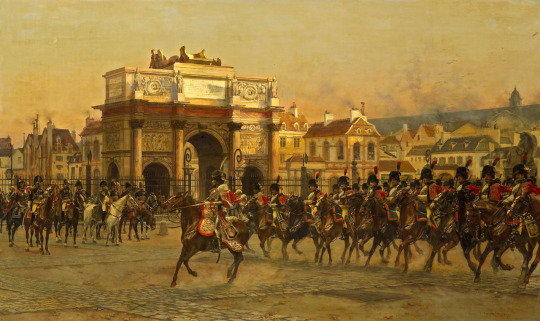
Napoleon and His Staff Reviewing the Mounted Chasseurs of the Imperial Guard at the Tuileries Palace
by François Flameng
#napoleon#napoléon#napoleon bonaparte#art#tuileries#palace#france#french#napoleonic#françois flameng#bonaparte#napoléon bonaparte#history#napoleonic wars#parade#paris#europe#european#chasseurs à cheval#chasseurs#cavalry
34 notes
·
View notes
Text
Laure about Bessières and Junot
In her memoirs, Laure for the time of her marriage (i.e., early Consulate) mentions Bessières as one of Junot's close friends:
Colonel Bessières, as he still only held that rank at the time, was at that time considered to be one of Junot's close friends.
However, with a caveat in a footnote:
Since then, this friendship cooled. I have always deplored the cause, which was as futile and ridiculous as possible, especially between two men such as Bessières and Junot, both young sprouts from the same tree and destined to live under its shade. I was the judge between the two of them, and I must say that I did not always rule in favour of Junot.
In the same chapter, Laure also mentions Bessières sharing his lodgings with Eugène and the two of them partying hard:
He was then colonel of the guides, i.e. the mounted chasseurs of the consular guard, together with Eugène Beauharnais. They were living in the same lodgings, and rumour had it that they were both very fond of all the joys that come with fortune and youth.
Does anybody happen to know what „futile and ridiculous“ thing caused the friendship between Bessières and Junot to break up? My first guess would have been a woman. But it might as well have been Bessières' catholicism?
#napoleon's marshals#jean baptiste bessières#napoleon's generals#jean andoche junot#napoleon's family#eugène de beauharnais#paris 1800#consulate
37 notes
·
View notes
Photo

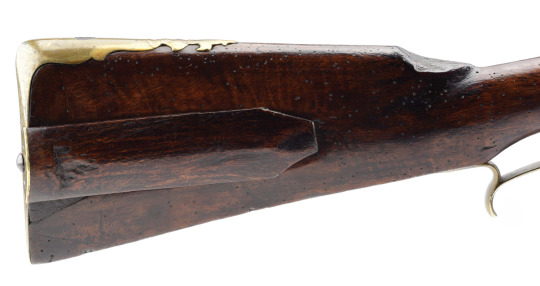
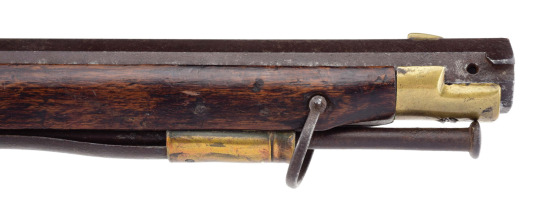
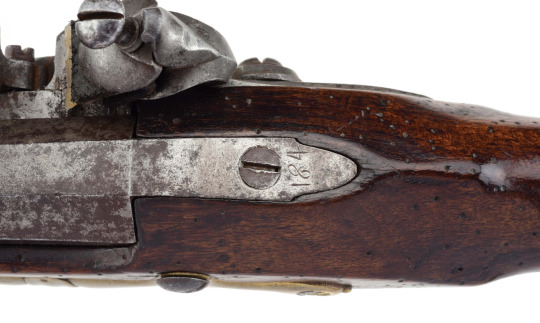

British Army 1776 Pattern Rifle.
One of two surviving examples, this one numbered '184' (the other, in a private American collection, numbered '196') of the 200 rifles ordered from August Heinrich Huhnstock of Hanover by the British Board of Ordnance on 4 January 1776 and upon which the Birmingham-made, British Pattern 1776 rifles were modeled. All 1000 rifles purchased by the Board of Ordnance (200 from Hanover and 800 from Birmingham makers) were shipped to America later that year. These rifles were initially issued to the provisional rifle platoon organized in each of the two battalions of British light infantry, as well as Provincial rifle-armed corps, such as Emmerick's Chasseurs and the rifle company of the New York Volunteers, and later to Ferguson's American Volunteers and the rifle company of the Queen's Rangers. German jaeger-style rifle with 27 5/8 in. L octagonal barrel of 0.68 caliber bore (for 0.625 cal. carbine ball), key-fastened, with rear sight (one pronounced standing and one hinged leaf, with vacant holes on each side near muzzle that once supported ramrod swivel, rifled with seven grooves, brass-bladed, fore-end sight, and plain breech with tang bearing an engraved, '184'. Flat beveled lock terminating in a point at tail, unmarked, with flat, goose-neck cock, faceted, bridle-less pan, and feather-spring with teardrop finial. Figured European walnut, full stock and bearing Ordnance storekeeper's stamp on left side of butt behind raised cheekpiece, with brass mounts including spur trigger-guard with trefoil finial ends, buttplate with trefoil end to its tang, three wide ramrod pipes (a steel ramrod spring between the fore-pipe and middle pipe), rounded "tailed" sideplate, and the 1 7/16 in. L nose-cap is indented 1/4 in. from its top edges for 1/2 in. from the front and inlet below to allow the swivel (now missing) to function, with sliding wooden patch-box, sling swivels and original iron ramrod. 43 1/4 in. Overall length: 44 in.
#rifle#gunblr#british army#history#military history#American revolution#revwar#American war of independence#british light infantry#redcoat#redcoats
97 notes
·
View notes
Text
Eylau

Soult’s corps had half its men out of action. Augereau’s no longer existed as a fighting entity. Davout’s was desperately engaged on the right. Murat brought up the whole of his cavalry, eighty squadrons. At the head of Grouchy’s dragoons, he trotted them across the exposed French front, and then, forming each squadron to the right, galloped them in line after line upon the Russian infantry. Grouchy’s dragoons, followed by Hautpoul’s cuirassiers, followed by Klein’s dragoons, and on the flanks Lasalle’s hussars, Milhaud’s chasseurs. The shock and fury were so great that the first two lines of the Russians were bowled completely over, and the French found themselves halted by the third and last line. They regrouped, but were now faced by the uninjured men who had turned about. They were caught between two fires, with not enough room to gather momentum to burst their way out. But Bessières charged with the mounted grenadiers and chasseurs of the Guard and, reopening the breach made by Murat’s horsemen, drove right through the remaining Russian line.
Napoleon had only to throw in his infantry to complete the destruction of the Russians [..]
Hubert Cole, The Betrayers
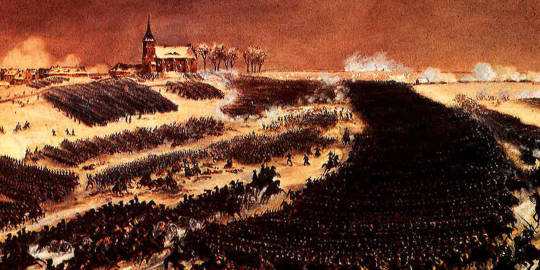
#napoleonic#hubert cole#the betrayers#battle of eylau#murat's charge#charge of eylau#bessières to the rescue
20 notes
·
View notes
Text
“A ball struck the prince’s horse”

[Illustration of Murat riding with one boot missing at Heilsberg, by Jacques Onfroy de Bréville.]
The following account of Murat at the battle of Heilsberg (10 June 1807) is attributed to a Brigadier General Henri (who served as aide to Murat that day), in the memoirs of Lieutenant Aubier of the 20th Chasseurs à Cheval.
***
On the murderous day of Heilsberg... I was detached from ordinance to be with Prince Murat. You know him: he is the general in chief of all our cavalry who is always dressed as a drum major and who takes the saber to the enemy like a true hussar.
Eh bien! For two hours of the day, Prince Murat was at the side of the Emperor, who was with the grenadier division, combined under the orders of General Oudinot. The Emperor and this general dismounted at a point elevated enough for His Majesty to look down on the enemy through his spyglass.
Prince Murat, arriving, dismounted, gave me his horse to hold, saluted the Emperor, took the hand of General Oudinot and began to talk with him. Suddenly a cloud of dust arose before us; the Emperor immediately directed his spyglass on this point, saying to Prince Murat:
--What is that, Monsieur?
--Nothing, Sire.
--Nothing, how is it nothing, Monsieur? Go take a closer look! And in pronouncing these words, the Emperor applied a vigorous blow of the whip to the buttocks of the horse of Prince Murat, who was already in the saddle.
(...)
The prince, his suite and I, we departed at the gallop.
--Follow me with your regiment, said the prince in passing by Colonel d'Ery, commanding the 5th Hussars, and we charged this mob.
In an instant we were engaged and were striking the first blows of the saber when a ball struck the prince's horse. I threw myself at once to the ground and, taking the bridle of the horse under my arms, aided the Prince in getting out from under his horse.
He left his left boot* there in the stirrup.
--It's nothing! It's nothing! A horse, said the prince.
I offered mine which was accepted, and the prince mounted, one foot booted and the other nude, like in the song. It was not in order to take himself out of danger that the prince had taken my horse; it was, on the contrary, to throw himself anew in the midst of the enemy, with the cries of: Forward! forward! Vive l'Empereur! and in a quarter of an hour, 3,000 to 4,000 Cossacks who had made themselves masters of the center of the plain were swept away like dust.
***
*Lieutenant Aubier goes on to describe this boot as "one of those superb boots in red morocco and all braided in gold that completed this magnificent costume 'of the drum major' of which the brigadier Henri speaks." He writes that this boot was actually rescued from being captured by the Cossacks by "a brigadier of the 8th Cuirassiers, Millot, who in effect threw himself into the midst of the Russians and, at the peril of his life, picked up and brought back this singular trophy."
Minutes after throwing himself back in the fray, Murat found himself in trouble once more:
He... was hardly in the saddle again when he was cut off and surrounded by a party of Russian dragoons. He was fighting for his life, when Lasalle in person arrived to the rescue, cutting down several of the enemy. A few minutes later, Murat saved Lasalle’s life in the mêlée. “We are quits now, my dear general,” he said, grasping his hand. It was because Murat, Prince of the Empire, Grand Duke of Berg, and Marshal of France, was thus ready to risk his life and fight like a man in the ranks, that all who followed him felt an admiring devotion for their daring leader. (Atteridge, 166-167)
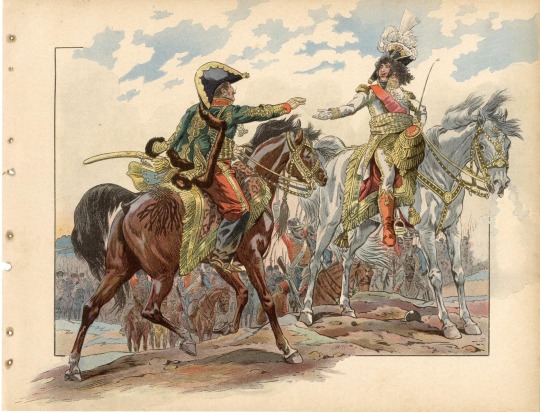
[Lasalle and Murat at Heilsberg after saving each other’s lives, by Jacques Onfroy de Bréville]
Sources:
-Lieutenant Aubier (20th Chasseurs), Un Régiment de Cavalerie Légère de 1793 à 1815, 2nd edition, 1891; pages 155-158.
-A. Hilliard Atteridge, Joachim Murat: Marshal of France and King of Naples, 1911.
(any errors in the translation of Aubier’s memoirs are my own)
37 notes
·
View notes